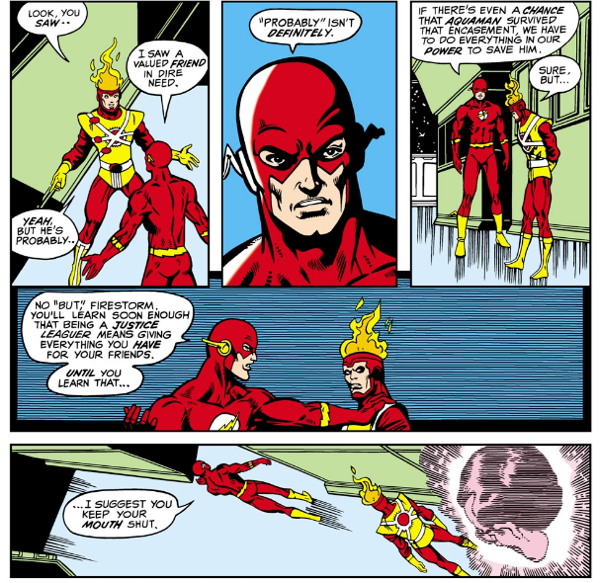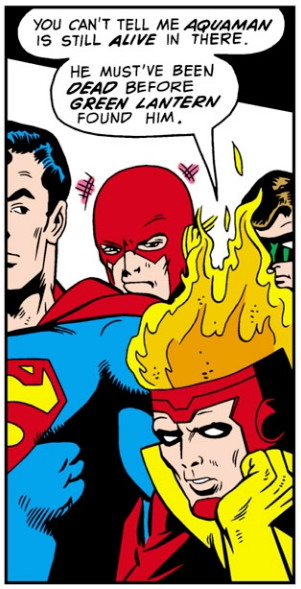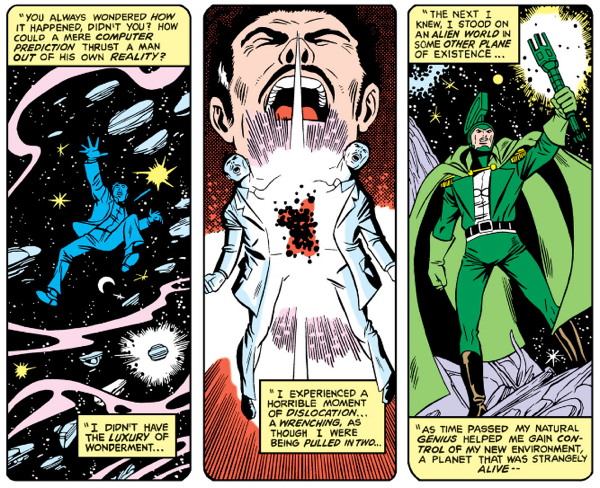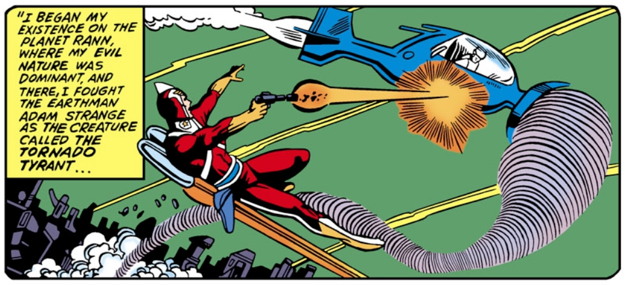In which I finally reach some measure of self-awareness at the end, there.
So I’ve been using the DC Universe Infinite digital comics service mostly to try to catch up on many of the comics I picked up but couldn’t read during the earlier and particularly bad months of my eyeball issues, when I wasn’t really able to read anything. I’ve also been using to dip a little farther back into DC’s publishing history, reading some Golden Age books, a lot of the earlier Silver Age Green Lantern (boy, does Hal call Tom that name a lot), and finally reading the entirety of Ostrander’s Suicide Squad run (which I missed during its initial publication). And I keep hoping they’ll add more late ’70s/early ’80s Superman comics to the catalog.
Anther purpose to which I’ve put DC Universe is revisiting some old favorites from my youth, my own copies either buried deep in the remainder of the Vast Mikester Comic Archives, or long since tattered into unreadability and discarded. One of those stories was the “Secret Origin of Red Tornado” two-parter that ran in Justice League of America #192 and #193 in 1981, when I was 12 years old.
I pointed out one short sequence in my last post, where I discussed the occasional brief focus of a team book on developing characters that had no other home on that stands. Now granted pretty much the entire focus of this story was on Red Tornado, but you know what I mean. Getting a little character development in for Reddy’s supporting cast because, you know, where else is that going to happen. (At least not until his own mini-series a few years later.)
Another bit of character development for someone who didn’t have his own title (but was featured in a back-up series in another comic at the time) was this, where the Flash admonishes Firestorm for prematurely (and loudly) giving up on a teammate for dead:

That sequence has stuck with me for a long, long time. Particularly this panel just before it, with Superman giving ol’ Flamehead the super side-eye:

You could just feel that burn of shame on Firestorm’s behalf. And in retrospect, it isn’t necessarily some tossed-away sequence to fill pages and create conflict between members of the team…this was written by Firestorm’s creator, who was also writing those back-ups over in The Flash. As such, it feels like an important part of the character’s development and not just something you could ignore because it didn’t happen in one of his “real” (i.e. solo) stories. I don’t think I appreciated this at the time, but now that I’m older (definitely) and wiser (jury’s still out) I certainly appreciate it now.
Another thing I appreciated about this comic, then and now, is just how much backstory got crammed into this comic. Well, “crammed,” relatively speaking, since this stories did run 52 pages over two issues (at only 50 cents a pop, even) so there felt like there was plenty of space. But there was a good chunk of the narrative given over to expository info needed for the reader to realize the importance of just what’s going on around here.
I mean, we get a retelling of Red Tornado’s beginnings:

We learn about the villain T.O. Morrow, his origin, and what he’s been up to since his last appearances:

There’s some bonus Adam Strange stuff, tying into the current story:

…and that’s not even all of what’s being shown and explained in this book. And it all reads very smoothly. As I said, I was 12 when this came out. I’d been reading comics for a bit, but I didn’t know much about characters like Firestorm and Red Tornado at the time, I certainly didn’t know T.O. Morrow, and while I knew Adam Strange mostly from being featured on the early Nickelodeon program Video Comics, I didn’t really know from the Tornado Tyrant.
It would seem like this is a lot to hit a kid relatively new to comics and some of these characters/concepts, but I do recall finding it absolutely fascinating. Finding out there was a history to these characters, still being referenced, still mattering, that happened long before I entered these worlds, gave the proceedings a depth that they would not have had otherwise. It’s a style of presentation that would shortly have me doing deep dives into Roy Thomas’s DC work, and its reverence for Golden Age tales.
I wasn’t put off…I was attracted by the idea that there was more to learn about all these characters and the worlds they lived in. I know, and I knew even then, that the shared universe at DC (and Marvel too) was built by Many Hands and inconsistencies abounded, but part of the fun was seeing what fit and what didn’t. It’s a feature, not a bug.
I’ve spoken about Crisis on Infinite Eaths before, and how its attempt at codifying and streamlining the DC Universe was compelling reading at the time…perhaps one of the very few times a comic book series had you genuinely concerned for the fate of those involved. It wasn’t until after patch after patch after patch was applied to that firmware upgrade that it began to sink in that the trip Wolfman and Perez took us on was, maybe, not really necessary. Reboots and relaunches began to pile on, and that long history for these characters began to evaporate.
The repeated relaunches of Legion of Super-Heroes threw away all their history in exchange for brief high bursts of first issue sales and slow declines. X-Men, a comic once read by, you know, everyone, splintered into endless spinoffs and relaunches, with no one easily able to follow the thread of stories and characters.
I know there are attempts to redress the shallowness of their fictional worlds. Nearly every crossover event at DC is about trying to make Crisis never-was, with the latest iteration being “every story matters,” however that’s going to work.
This whole post reads like “why aren’t comics like they were when I was a kid,” which comes awfully close to lumping me in with those “comics were never political!” people, and nobody wants that. Comics are always evolving and changing and trying to find their place in a world where they’ve been largely supplanted by, ironically enough, their own enormously popular TV and movie adaptations. There is still lots of good work being done with them, and I still love reading (and selling!) them.
But I do miss the feeling I had of dipping into some comic I hadn’t read before and realizing there’s a whole world here that I’m only barely experiencing in this one issue. Maybe I’ve read comics for too long to have that happen now. Or maybe I’m assuming too much, and that kids do have that same wonder, just not with the same types of comics I read. There’s someone out there whose first volume of Naruto is number 81 and being intrigued by what they’ve discovered, the same way I was 40 years ago, when I decided to pick a comic off the rack that promised secrets to be revealed about Red Tornado.








I can relate to your experience. I’m a couple of years younger but read some of the #170-190 JLA stories once they were translated and published here in Germany. At that time you had to actively hunt for superhero comics, Mickey Mouse and Donald Duck being way more popular over here.
Seeing some character for the first time and how they interacted with Batman or Superman always made me want to find out more about them.
The most widely available books were Superman and mostly Batmans but they weren’t Batman comics, nono. They were HANEY B&Bs. So this month you’d meet Man-Bat, next month Scalphunter, then Deadman, Firestorm, GL, Ragman and then a double whammy of Elongated Man and Plastic Man. Likewise Superman books were often based on DC Presents.
Now for every twenty of these you’d happen upon a JLA book (satellite era) every other leap year. And let me tell you, every kid was like “Wow, all those heroes in one book”.
No one needed any wikipedia for that, you took what you got and were thankful for it. Less so if it was a “to be continued” story, since no way were you ever gonna get that second part.
Sure, we often wondered what was up with the Phantom Stranger or Java or how Triplicate Girl was turned into Duo Damsel but that never diminished the appeal of every story. And it made us want to read more comics to find out.
This is probably not the response you wanted, but I am moved to make a few observations about T.O. Morrow.
1. Boy, the DC writers were really firm believers in nominative determinism, weren’t they? I wonder if they made John Broome do all the sweeping in the office.
2. I presume that, during Roy Thomas’s time at DC, he established that T.O. Morrow was an ancestor of Tommy Tomorrow.
3. Morrow is definitely high on the list of “comic book villains who could have made legitimate fortunes with their gimmicks.” I am not sure if he comes before or ahead of the Weather Wizard (“I can control the weather! Let’s see, what should I do with that power? Hire myself out to end droughts and make deserts habitable? No, I think I’ll try robbing banks.”).
3a. Mind, I am not sure if there is any villain whose misuse of his gimmick is greater than that of Ray Palmer. I mean, if you had discovered a means of temporarily shrinking objects and people while having complete control of their weight, which would be your first response? 1) “Better clear some space on my mantle for my Nobel Prize.” 2) “This will revolutionize the haulage business! I’m going to make a fortune!” 3) “Great, now I can put on tights and punch criminals!”
4. If Morrow were a Marvel character, he would have been revealed as a version of Kang the Conqueror by now. You know, the original decision to consolidate several characters into Kang was based on the realization that Marvel had a whole bunch of villains all with the same gimmick–i.e., they were time travelers trying to use future technology to conquer the past. Revealing them all to have been Kang all along was just a way of reducing redundancy. However, the lesson Marvel’s writers took from this was not “Maybe we should try to be a bit original” but “The key characteristic of Kang is that he has a lot of identities. Therefore, if I ever write a story about Kang, I will make sure to give him a new identity.” The result is that there are now 73 versions of Kang floating around in the Marvel universe, with a new one added every year.
Oh, by the way: As best I can tell, DC Universe Infinite does not currently carry any issues of STAR-SPANGLED COMICS. If it ever adds them, be sure to check out Jimmy Thompson’s run on “Robotman.”
It might be reductive, but maybe the upshot is that it is impossible to sustain coherence in a serial narrative for over 80 years, especially when multiple creators are involved.
There really is a sweet spot between “dense history that attracts new readers” and “convoluted history that repels new readers.” It seems like the comics community is constantly debating where that spot is.
I agree that there must still be new readers who want to dig into past stories. One of the current barriers to entry, though, is the constant relaunching of titles. In your example, you could dig back through the Justice League of America box at your LCS to find a lot of the previous adventures of Red Tornado or Firestorm.
These days, if you want to go back in time with a character like Jean Gray, you’ve got to dig back through a couple of “X-Men” and “Uncanny X-Men” relaunches, “X-Men: Red,” side-teams like the current “X-Force,” and more than one mini-series. Not impossible, but definitely more difficult.
Weirdly, I think the fracturing of the comics landscape also began around the time of Crisis on Infinite Earths. If you could renumber series like Superman and Wonder Woman, then you could really renumber any title. It just took 25 years or so to catch up to Action and Detective Comics. DC regretted that decision pretty quickly, though.
I think that there are two continents of comic readers.,.the “lifers” and the “faddists”.
The idea that comics appeal to readers by their continuity and their shared history is what draws in us “lifers”. That’s why we’re still here talking about comic books on the internet after we were told we were “too old for that stuff”.
Now, Marvel and DC may have lost some of this contingent of readers with their decisions to jettison so much continuity.
However, they don’t really need to worry too much about us. We are their base. We can pretty much always be counted on to keep following our favourite characters on a regular basis.
However, the problem is with the “casual” readership.
These are mainly younger readers.
They discover comics. Enjoy reading them for a while. Then move on to other things.
Obviously, they don’t care about the past and shared history of all these characters…at least beyond knowing why Batman and Superman are on the same super-team. That sort of thing.
Now, granted, us “lifers” come from this larger pool. Most of us started reading comics as kids and got obsessed with the shared universe and decided to keep buying comics.
It’s the “casual” readership which is being lost. That contingent is about turn-over.
The comic business needs each new generation to discover comics. Devote a few years to collecting, and then they move on to be replaced by the next generation.
Personally, I think the problem simply comes down to cost.
When we were kids and got a $5 allowance or got an after school neighbourhood job, we could buy lots and lots of comics.
Even up to the point when comics cost $1.25, kids could still collect four comics a week (or whatever).
Now, a kid can choose one comic to buy. That’s just far too expensive.
So, that all-important pool of “casuals” that kept comics healthy are drying up.
I don’t think the problem is “too little continuity” or “too much continuity”.
Turan-Don’t forget Zarrko, the Tomorrow Man. He is not a Kang…at least, not yet.
“and finally reading the entirety of Ostrander’s Suicide Squad run (which I missed during its initial publication”
You missed those? They were great! One of only 4 titles I was buying at the time!